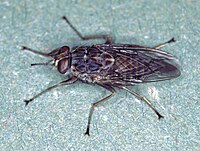
Genetic diversity and population structure of the tsetse fly Glossina fuscipes fuscipes (Diptera: Glossinidae) in Northern Uganda: Implications for vector control
Sign Up to like & getrecommendations! Published in 2017 at "PLoS Neglected Tropical Diseases"
DOI: 10.1371/journal.pntd.0005485
Abstract: Uganda is the only country where the chronic and acute forms of human African Trypanosomiasis (HAT) or sleeping sickness both occur and are separated by < 100 km in areas north of Lake Kyoga. In… read more here.
Keywords: vector; lake kyoga; fuscipes fuscipes; drainage ... See more keywords

Infection with endosymbiotic Spiroplasma disrupts tsetse (Glossina fuscipes fuscipes) metabolic and reproductive homeostasis
Sign Up to like & getrecommendations! Published in 2021 at "PLoS Pathogens"
DOI: 10.1371/journal.ppat.1009539
Abstract: Tsetse flies (Glossina spp.) house a population-dependent assortment of microorganisms that can include pathogenic African trypanosomes and maternally transmitted endosymbiotic bacteria, the latter of which mediate numerous aspects of their host’s metabolic, reproductive, and immune… read more here.
Keywords: metabolic reproductive; fuscipes fuscipes; spiroplasma; endosymbiotic spiroplasma ... See more keywords

On the genetic basis of the effect of Spiroplasma on the male reproductive fitness of Glossina fuscipes fuscipes
Sign Up to like & getrecommendations! Published in 2022 at "PLoS Pathogens"
DOI: 10.1371/journal.ppat.1010442
Abstract: Son and colleagues recently reported [1] the phenotypic effects of the infection of the endo-symbiont Spiroplasma in the tsetse fly Glossina fuscipes fuscipes , a major disease vector in humans. The authors examined the impact… read more here.
Keywords: fuscipes fuscipes; effect; glossina fuscipes; male reproductive ... See more keywords

Cellular and Molecular Targets of Waterbuck Repellent Blend Odors in Antennae of Glossina fuscipes fuscipes Newstead, 1910
Sign Up to like & getrecommendations! Published in 2020 at "Frontiers in Cellular Neuroscience"
DOI: 10.3389/fncel.2020.00137
Abstract: Insects that transmit many of the world’s deadliest animal diseases, for instance trypanosomosis, find their suitable hosts and avoid non-preferred hosts mostly through olfactory cues. The waterbuck repellent blend (WRB) comprising geranylacetone, guaiacol, pentanoic acid,… read more here.
Keywords: waterbuck repellent; fuscipes fuscipes; repellent blend; fuscipes newstead ... See more keywords